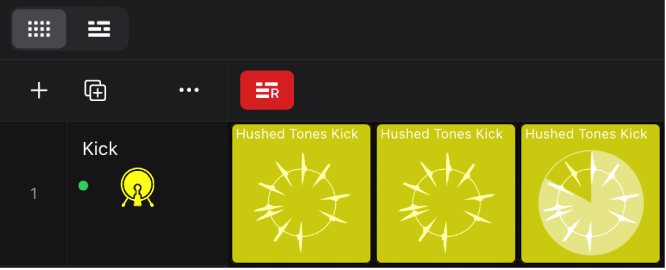Logic Pro User Guide for iPad
- What’s new in Logic Pro 1.1
-
- What is Logic Pro?
- Working areas
- Work with function buttons
- Work with numeric values
-
- Intro to tracks
- Create tracks
- Create tracks using drag and drop
- Choose the default region type for a software instrument track
- Select tracks
- Duplicate tracks
- Reorder tracks
- Rename tracks
- Change track icons
- Change track colors
- Use the tuner on an audio track
- Show the output track in the Tracks area
- Delete tracks
- Edit track parameters
- Start a Logic Pro subscription
- How to get help
-
- Intro to recording
-
- Before recording software instruments
- Record software instruments
- Record additional software instrument takes
- Record to multiple software instrument tracks
- Record multiple MIDI devices to multiple tracks
- Record software instruments and audio simultaneously
- Merge software instrument recordings
- Spot erase software instrument recordings
- Replace software instrument recordings
- Capture your most recent MIDI performance
- Use the metronome
- Use the count-in
-
- Intro to arranging
-
- Intro to regions
- Select regions
- Cut, copy, and paste regions
- Move regions
- Remove gaps between regions
- Delay region playback
- Trim regions
- Loop regions
- Repeat regions
- Mute regions
- Split and join regions
- Stretch regions
- Separate a MIDI region by note pitch
- Bounce regions in place
- Change the gain of audio regions
- Create regions in the Tracks area
- Convert a MIDI region to a Drummer region or a pattern region
- Rename regions
- Change the color of regions
- Delete regions
- Create fades on audio regions
- Access mixing functions using the Fader
-
- Intro to Step Sequencer
- Use Step Sequencer with Drum Machine Designer
- Record Step Sequencer patterns live
- Step record Step Sequencer patterns
- Load and save patterns
- Modify pattern playback
- Edit steps
- Edit rows
- Edit Step Sequencer pattern, row, and step settings in the inspector
- Customize Step Sequencer
-
- Effect plug-ins overview
-
- Instrument plug-ins overview
-
- ES2 overview
- Interface overview
-
- Modulation overview
-
- Vector Envelope overview
- Use Vector Envelope points
- Use Vector Envelope solo and sustain points
- Set Vector Envelope segment times
- Vector Envelope XY pad controls
- Vector Envelope Actions menu
- Vector Envelope loop controls
- Vector Envelope release phase behavior
- Vector Envelope point transition shapes
- Use Vector Envelope time scaling
- Use the Mod Pad
- Modulation source reference
- Via modulation source reference
-
- Sample Alchemy overview
- Interface overview
- Add source material
- Save a preset
- Edit mode
- Play modes
- Source overview
- Synthesis modes
- Granular controls
- Additive effects
- Additive effect controls
- Spectral effect
- Spectral effect controls
- Filter module
- Low and highpass filter
- Comb PM filter
- Downsampler filter
- FM filter
- Envelope generators
- Mod Matrix
- Modulation routing
- Motion mode
- Trim mode
- More menu
- Sampler
- Copyright
Record a Live Loops performance in Logic Pro for iPad
When you record a Live Loops performance, the cells that you play as part of the performance appear as regions in the Tracks area. After you are done recording your performance, you can play it back in the Tracks area, edit the regions, and finalize the mix just as you would with any other Logic Pro project.
You cannot record to a cell while recording a Live Loops performance. However, you can record to an audio or software instrument track. This lets you record a vocal or instrument performance, for example, along with the Live Loops performance.

Record a Live Loops performance
In Logic Pro, tap the Enable Performance Recording button
 in the upper-left corner of the Live Loops grid.
in the upper-left corner of the Live Loops grid.Make sure that Cycle mode is turned off (tap the Cycle button
 in the control bar) and the project playhead in the Tracks area is positioned where you want to start recording your Live Loops performance.
in the control bar) and the project playhead in the Tracks area is positioned where you want to start recording your Live Loops performance.Tap the Record button
 in the control bar to start recording.
in the control bar to start recording.Start playing scenes, cells, or a combination of both. If you queue cells or scenes before you start recording, they start playing when recording starts.
The cells that you play as part of the performance are recorded as regions in the Tracks area.
To stop recording, do either of the following:
Tap the Stop button
 in the control bar.
in the control bar.The Live Loops performance stops recording, and the cells that were playing are now queued.
Tap the Play button
 in the control bar.
in the control bar.The Live Loops performance stops recording, but the project continues to play.
When you record a Live Loops performance, you can also record changes to track controls and effect parameters using automation. See Intro to automation in Logic Pro for iPad.
Download this guide: PDF